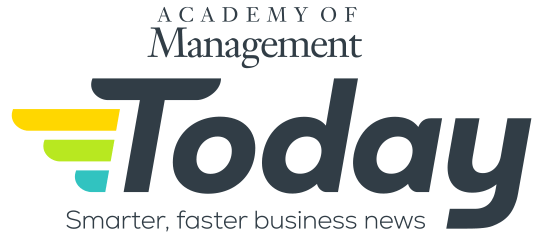Up next....
Why Work Frenemies Are More Common than Work Friends
By Daniel Butcher
In our portfolio of relationships, we want as many friends and as few enemies as possible. But many work relationships aren’t clearly positive or negative; instead, they’re more neutral, like cordial acquaintances, or even ambivalent. Think “frenemies,” two-faced colleagues, or polite rivals. While having mixed feelings about a coworker sounds awkward—and research studies have shown that frenemies increase each other’s stress and blood pressure—ambivalent relationships also tend to boost creativity, adaptability, and productivity by fueling a competitive spark.
“Ambivalent relationships have always been relatively common in organizations, as they are breeding grounds for having to simultaneously collaborate and compete, for example,” said Academy of Management Scholar Jessica Methot of Rutgers University and the University of Exeter. “But because some of the more complicated interpersonal interactions were paused or transformed during the COVID-19 pandemic, workplace relationships seemed to become more one-dimensional.
“Either someone was unreliable or difficult to work with, or they were motivated and helpful,” she said. “Now, in the ‘post-pandemic’ world of work, we’re starting to see ambivalent relationships emerge again.”
Methot has been doing research to better understand how and why friendships necessarily blur work and non-work boundaries to create unique tensions. That holds true for both remote and in-person work as well.
“It’s important for people to understand how to balance when we’re exposing our personal or intimate information to someone who we work with, and the paradox and the complications that come along with that,” she said. “A lot of people want to have those close relationships and those experiences with the people who they work with but maybe don’t really understand how that can turn against them.
“The issue with workplace friendships that makes them distinct and unique from relationships or friendships outside of work is that the shared space is the office, and so the friendship is founded on a professional work relationship, and those two things tend to compete with each other.”
Especially for team members of comparable seniority, it can be difficult to reconcile the fact that they are collaborating with each other at the same time that they may be competing with each other.
“A formal work relationship is transactional, professional, and non-discretionary, versus our private, more discretionary, informal friendships, and those two things tend to conflict with each other,” Methot said. “How do we balance these paradoxes or tensions that we end up facing when we try to become friends with people who we work with?
“It ends up potentially creating these rivalries—we might be both going up for the same promotion,” she said. “I want to be proud of my friend and happy for him or her, but I’m also jealous, and so this started leading into my research understanding how we feel ambivalently towards our friendships.
“Work friends must deal with this emotion of ambivalence, where we might feel joy or pride and jealousy, and the question is, ‘How do we balance those emotions?’”
A sample of Methot’s AOM research findings:
-
Daniel Butcher is a writer and the Managing Editor of AOM Today at the Academy of Management (AOM). Previously, he was a writer and the Finance Editor for Strategic Finance magazine and Management Accounting Quarterly, a scholarly journal, at the Institute of Management Accountants (IMA). Prior to that, he worked as a writer/editor at The Financial Times, including daily FT sister publications Ignites and FundFire, as well as Crain Communications’s InvestmentNews and Crain’s Wealth, eFinancialCareers, and Arizent’s Financial Planning, Re:Invent|Wealth, On Wall Street, Bank Investment Consultant, and Money Management Executive. He earned his bachelor’s degree from the University of Colorado Boulder and his master’s degree from New York University. You can reach him at dbutcher@aom.org or via LinkedIn.
View all posts
Up next....
Why It’s Important to Thank Helpful Coworkers
By Daniel Butcher
Even top performers can get into a funk a work, and workers who usually are willing to help coworkers can stop collaborating. Beyond standard strategies such as promotions and raises, cultivating a collaborative culture that gives credit where credit is due is crucial for motivating such talented, helpful employees.
Academy of Management Scholar Abbie Shipp of Texas Christian University, who coauthored an Academy of Management Review article on how “organizational citizenship behavior” changes over time with Jessica Methot of Rutgers University, David Lepak of the University of Massachusetts Amherst, and Wendy Boswell of Texas A&M University, said that people continuously craft identity narratives to tell evolving stories about themselves.
“The research on organizational citizenship behavior took this approach of ‘People either help colleagues or they don’t,’ not really viewing a longer-term perspective or asking questions such as, ‘What happens if I help all the time and then I get burnt out?’ or ‘What if something happens at work and changes my identity to where I help colleagues more or less often?’” Shipp said.
“We looked at the ways in which some different situations or life cues could change your trajectory of helping over time, and why,” she said. “In terms of practical takeaways, talk to people about their identities and why they help at work and what’s meaningful to them—but also assume that these will change, so keep those conversations going.
“If somebody is one of your top performers today, don’t assume that that would stick.”
There could be ebbs and flows and different events that could—and likely will—impact performance and citizenship behavior.
“When you take that temporal lens, you start to really ask a lot of different questions about, ‘When do people help? How does it change? Is that temporary or permanent?’ etc.,” Shipp said.
“This allows leaders to explore ways to boost the morale of top performers and helpers and encourage them to remain at the organization, continue performing well, and continue to help others, even when things change over time,” she said.
A sample of Shipp’sAOM research findings:
-
Daniel Butcher is a writer and the Managing Editor of AOM Today at the Academy of Management (AOM). Previously, he was a writer and the Finance Editor for Strategic Finance magazine and Management Accounting Quarterly, a scholarly journal, at the Institute of Management Accountants (IMA). Prior to that, he worked as a writer/editor at The Financial Times, including daily FT sister publications Ignites and FundFire, as well as Crain Communications’s InvestmentNews and Crain’s Wealth, eFinancialCareers, and Arizent’s Financial Planning, Re:Invent|Wealth, On Wall Street, Bank Investment Consultant, and Money Management Executive. He earned his bachelor’s degree from the University of Colorado Boulder and his master’s degree from New York University. You can reach him at dbutcher@aom.org or via LinkedIn.
View all posts
Up next....
How Tech Can Support Connecting via Remote Work
By Daniel Butcher
Some people hate virtual meetings and calls and prefer face-to-face in-person interactions. Others are uncomfortable in a traditional office setting and prefer communicating in ways that are mediated by technology. Many people fall somewhere in between. But small talk is valuable for everyone.
Academy of Management Scholar Jessica Methot of Rutgers University and the University of Exeter—who cowrote an Academy of Management Journal article on that topic with Emily Rosado-Solomon of Babson College, Patrick Downes of the University of Kansas, and Allison Gabriel of Purdue University—said that she has talked to a lot of people whose teams or organizations are now using Slack, Teams, or other communication software and provided the following advice:
“Set up informal interaction channels over Slack to give employees an outlet where they can talk about exercise or leisure or any hobbies that they have that doesn’t necessarily have to implicate work-related topics,” Methot said. “Giving them an outlet to talk informally with each other can be really helpful.”
This doesn’t always apply to, say, neurodivergent individuals or other people with disabilities or people who are from minoritized backgrounds, or even expatriates, she noted.
“Small talk is actually really challenging for people who don’t understand American norms, and we’ve heard that from a lot of immigrants, expatriates who don’t have the context for how to get involved in the conversations with those familiar with a particular country’s cultural norms and trends,” Methot said. “For Americans, it seems accepted and relatively normal.
“We understand that it’s polite to engage in conversation, but we talk about topics that they might not be familiar with, things related to hobbies or sports or network television, and they feel excluded,” she said
“Also, the idea of returning to the office might not feel as accepting or welcoming for certain populations, like those who are neurodivergent.”
While many people bemoan the disruption to traditional nine-to-five office schedules, for many others such as parents and people with disabilities, remote or hybrid work arrangements are a breath of fresh air.
“For some people, technology has really vastly improved their social circles, work-life balance, and ability to present themselves more authentically,” Methot said.
“Stigmatized groups might struggle to live and work in their environment when they have disabilities, or for individuals who are neurodivergent, it’s harder for them to form in-person connections, and so interacting online can really be a lifeline for them,” she said.
“I want to make sure that I’m addressing the fact that encouraging small talk isn’t a blanket set of practices or results that apply to everyone.”
A sample of Methot’s AOM research findings:
-
Daniel Butcher is a writer and the Managing Editor of AOM Today at the Academy of Management (AOM). Previously, he was a writer and the Finance Editor for Strategic Finance magazine and Management Accounting Quarterly, a scholarly journal, at the Institute of Management Accountants (IMA). Prior to that, he worked as a writer/editor at The Financial Times, including daily FT sister publications Ignites and FundFire, as well as Crain Communications’s InvestmentNews and Crain’s Wealth, eFinancialCareers, and Arizent’s Financial Planning, Re:Invent|Wealth, On Wall Street, Bank Investment Consultant, and Money Management Executive. He earned his bachelor’s degree from the University of Colorado Boulder and his master’s degree from New York University. You can reach him at dbutcher@aom.org or via LinkedIn.
View all posts
Up next....
The Importance of Social Rituals at Work
By Daniel Butcher
Whether you’re a CEO or rank-and-file employee, and no matter how good you are at the nuts-and-bolts aspects of your job, ignore social-emotional factors in the workplace at your peril.
Academy of Management Scholar Jessica Methot of Rutgers University and the University of Exeter—who coauthored an Academy of Management Journal article on that topic with Emily Rosado-Solomon of Babson College, Patrick Downes of the University of Kansas, and Allison Gabriel of Purdue University—said that it’s important to ask ourselves questions such as: Am I feeling especially disconnected today? Have I talked to anyone outside of my home?
“We can assess our own social-emotional health and how much time we spend interacting with other people—don’t fall victim to mistakenly seeking solitude,” Methot said. “Some people tend to avoid small talk, either because they overestimate how awkward they seem or they don’t see any benefits to it.
“Part of it is elevating and highlighting the benefits of having small talk, because it isn’t difficult; it doesn’t take too much effort; it isn’t too intimate, and it still helps boost our energy,” she said. “Remotely, we want to think about how we can recreate or create new social rituals for our teams.”
Social rituals at work include weekly check-ins, project retrospectives, and celebratory events for milestones or achievements.
“If we’re bringing our team back into the office, let’s say we’ve got a group who was working remotely or is working in a hybrid schedule, we might not be able to go back to the way that it was and recreate the exact workplace situation or climate that we had before,” Methot said.
Most people—bosses and employees alike—have to adapt to changing work environments. Creating new social rituals fosters better teamwork and helps with maintaining a positive culture.
“What does this new social ritual look like? What does our team need now? How can we innovate but still ensure that we use that as a norm in our team or in our organization,” Methot said. “We can also integrate spontaneous conversations into our remote work ecosystem, so we and colleagues could try setting our availability, specifying times for when others can connect with us.
“A social ritual could be as simple as encouraging team members to join meetings five minutes early to catch up informally and say, ‘Hey, how’s everyone doing?’”
A sample of Methot’s AOM research findings:
-
Daniel Butcher is a writer and the Managing Editor of AOM Today at the Academy of Management (AOM). Previously, he was a writer and the Finance Editor for Strategic Finance magazine and Management Accounting Quarterly, a scholarly journal, at the Institute of Management Accountants (IMA). Prior to that, he worked as a writer/editor at The Financial Times, including daily FT sister publications Ignites and FundFire, as well as Crain Communications’s InvestmentNews and Crain’s Wealth, eFinancialCareers, and Arizent’s Financial Planning, Re:Invent|Wealth, On Wall Street, Bank Investment Consultant, and Money Management Executive. He earned his bachelor’s degree from the University of Colorado Boulder and his master’s degree from New York University. You can reach him at dbutcher@aom.org or via LinkedIn.
View all posts
Up next....
Why Small Talk Is Social Glue at Work
By Daniel Butcher
Small talk is crucial for employees to bond with each other and form a cohesive organizational culture—and hybrid and even fully remote work arrangements don’t change that.
Academy of Management Scholar Jessica Methot of Rutgers University and the University of Exeter—who coauthored an Academy of Management Journal article on that topic with Emily Rosado-Solomon of Babson College, Patrick Downes of the University of Kansas, and Allison Gabriel of Purdue University—said that they collected the data about why and how small talk can be an effective method for employee bonding before the COVID-19 pandemic.
“A lot of the conclusions that we drew about the impact of small talk on employees were seemingly turned on their head when everyone started working remotely,” Methot said. “The questions people asked us were, ‘How do we do this if we’re working remotely? How do we reconstruct these work relationships if we can’t just bump into each other in the hallway?
“It was a great challenge for us to think through, “How did small talk change during Covid, and what does this look like now in the post-Covid age?” she said. “It is so prevalent that we wanted to understand what was happening in organizations: Was it good? Was it bad? Is this something that we should be encouraging? Do we have any control over it whatsoever?”
Small talk can be a polarizing topic. Some people love it, while others hate it.
“It’s also sometimes cultural, where having chit-chat feels superficial and condescending and unnecessary, where others feel as though, if you don’t chit-chat with them, you’re not even acknowledging their presence, and it’s rude,” Methot said. “It makes up a really large chunk—about one-third—of our conversations, and it’s the social glue of the workplace.
“Small talk with our colleagues is a social ritual that many of us had built into our days,” she said. “We come into the office; we greet people in the morning; we chat with coworkers to pass the time; we take a break to grab a coffee; we reenergize before getting back to work.
“We make small talk in transition periods—we have small talk before going into a meeting, before negotiations, before performance evaluations, and so we also use it to grease the wheels.”
A sample of Methot’s AOM research findings:
-
Daniel Butcher is a writer and the Managing Editor of AOM Today at the Academy of Management (AOM). Previously, he was a writer and the Finance Editor for Strategic Finance magazine and Management Accounting Quarterly, a scholarly journal, at the Institute of Management Accountants (IMA). Prior to that, he worked as a writer/editor at The Financial Times, including daily FT sister publications Ignites and FundFire, as well as Crain Communications’s InvestmentNews and Crain’s Wealth, eFinancialCareers, and Arizent’s Financial Planning, Re:Invent|Wealth, On Wall Street, Bank Investment Consultant, and Money Management Executive. He earned his bachelor’s degree from the University of Colorado Boulder and his master’s degree from New York University. You can reach him at dbutcher@aom.org or via LinkedIn.
View all posts
Up next....
RTO Has a Steep Learning Curve for Young Workers
By Daniel Butcher
Many young employees, some of whom graduated during the COVID-19 pandemic or took on a fully remote role after graduation, never experienced integrating with—and thriving in—an office culture. Pandemic or no, young professionals often experience a learning curve in transitioning to becoming a professional. They have to figure out how to bond with fellow employees, make a good impression on management, and act professionally in an office.
Academy of Management Scholar Jessica Methot of Rutgers University and the University of Exeter said that many early-career workers haven’t been fully socialized into their employer’s culture. The quality of organizations’ onboarding procedures varies widely.
“One of the concerns that we’ve been hearing a lot from newer employees is they weren’t onboarded effectively,” Methot said. “They’re brought into a new role, but they don’t get a chance to meet the team, develop a rapport with their boss, or form relationships with this team to build trust and learn how to collaborate effectively with them.
“Maybe they worked remotely when they were hired into the organization, and then—all of a sudden—they’re brought back to the workspace, and now they have to reevaluate how they were interacting with these individuals and almost create new relationships with them,” she said. “The pandemic created this disruption to our understanding of how to interact, and so it calls into question what types of information do recent hires require?
“How are we socializing these new employees to help them navigate the social norms and political landscape of the organization? How do they build a relationship with their supervisor or their direct reports when they never meet in person, and then, what does that look like if a group of them is required to come back to the office? It’s really disruptive.”
A sample of Methot’s AOM research findings:
-
Daniel Butcher is a writer and the Managing Editor of AOM Today at the Academy of Management (AOM). Previously, he was a writer and the Finance Editor for Strategic Finance magazine and Management Accounting Quarterly, a scholarly journal, at the Institute of Management Accountants (IMA). Prior to that, he worked as a writer/editor at The Financial Times, including daily FT sister publications Ignites and FundFire, as well as Crain Communications’s InvestmentNews and Crain’s Wealth, eFinancialCareers, and Arizent’s Financial Planning, Re:Invent|Wealth, On Wall Street, Bank Investment Consultant, and Money Management Executive. He earned his bachelor’s degree from the University of Colorado Boulder and his master’s degree from New York University. You can reach him at dbutcher@aom.org or via LinkedIn.
View all posts
Up next....
For Candidates and New Hires, Fitting in Is as Crucial as Skills
By Daniel Butcher
It’s a best practice for organizations to identify both formal and informal employee networks, establish how networks could change, and identify the specific human-resources (HR) practices that could affect those different networks. All of that will affect employees’ collaboration, efficiency, and productivity.
Academy of Management Scholar Jessica Methot of Rutgers University and the University of Exeter—who cowrote an Academy of Management Review article on this topic with Emily Rosado-Solomon of Babson College and David Allen of Texas Christian University and University of Warwick—said it’s important to analyze how different HR practices, including recruitment priorities and tactics, may affect employee relationships.
“We know that organizations focus on different types of recruitment strategies; if we home in on this one type of recruitment strategy, what does that mean for the composition of employees’ networks?” Methot said. “If we select candidates based on certain competencies, what does that mean for people’s network size or who’s in that network?
“A lot of this was grounded in the idea that human-resource management traditionally has been really deeply rooted in the idea of human capital—individuals’ knowledge, skills, abilities, expertise, functional areas, training, etc.—and trying to hire the best people based on their human capital, trying to train our employees so they have the knowledge and skills that they need to do that job well, and managing performance based on that human capital,” she said. “How are they demonstrating those competencies and using those skills?
“If we adopt this particular HR practice, what does that mean for the types of people and how they’re interacting in the organization?”
Methot and research colleagues identified three different dimensions to describe the composition of a network.
“This is who is in your personal network—as an employee, how many people are in my personal network, and who are those people?” Methot said. “The configuration of the network is the pattern of relationships and the structure of the network connecting them.
“Is everyone in my community connected? Do they all know each other? Do they all share information? Or are we siloed or disconnected? Are there bottlenecks?” she said.
“The content of those relationships refers to the properties or the definition of those relationships, from workplace collaborator to friend, how strong those relationships are, the degree of trust between employees in a given network, and what they’re communicating about, ranging from small talk and work tasks to personal information and gossip.”
A sample of Methot’s AOM research findings:
-
Daniel Butcher is a writer and the Managing Editor of AOM Today at the Academy of Management (AOM). Previously, he was a writer and the Finance Editor for Strategic Finance magazine and Management Accounting Quarterly, a scholarly journal, at the Institute of Management Accountants (IMA). Prior to that, he worked as a writer/editor at The Financial Times, including daily FT sister publications Ignites and FundFire, as well as Crain Communications’s InvestmentNews and Crain’s Wealth, eFinancialCareers, and Arizent’s Financial Planning, Re:Invent|Wealth, On Wall Street, Bank Investment Consultant, and Money Management Executive. He earned his bachelor’s degree from the University of Colorado Boulder and his master’s degree from New York University. You can reach him at dbutcher@aom.org or via LinkedIn.
View all posts
Up next....
The Pros of Small Talk at Work Outweigh the Cons
By Daniel Butcher
While there is some evidence that employees who go overboard making small talk can be less productive, occasional nonwork chats with colleagues can boost workers’ sense of well-being, belonging, loyalty to their organization. It also improves teamwork.
Academy of Management Scholar Jessica Methot of Rutgers University and the University of Exeter—who cowrote an Academy of Management Journal article on that topic with Emily Rosado-Solomon of Babson College, Patrick Downes of the University of Kansas, and Allison Gabriel of Purdue University—said that they found that small talk increases employees’ morale and improves bonding and collaboration.
“Small talk eases transitions—we rarely begin a meeting or pop into someone else’s office without a little small talk, just to grease the wheels and ease into the work-related conversation, and it helps us move from one activity to another,” Methot said. “We have small talk before meetings, interviews, performance evaluation, sales pitches, and negotiations.
“It is this social ritual that helps us transition from one activity to another and sets the stage for building relationships,” she said. “At a very basic level, it simply shows that we recognize someone else’s presence—it’s an acknowledgement.
“It makes us feel better when someone waves to us and smiles or says hello or chats with us, and so it sets a positive tone to a relationship, and as we continue to do that over time with colleagues, we start to build a stronger sense of trust and potentially things like friendships.”
Why does small talk have these effects?
Methot and her coauthors found that on days people made more small talk than they normally would, they experienced a boost in mood and positive energy, which, in turn, increased their positive social behaviors.
“Small talk boosted the extent to which they went out of their way to help their colleagues, and it increased their well-being,” Methot said.
“It had these great positive spillover effects where just simply having more small talk than they normally would on a given day really elevated their affect, their energy, and the extent to which they were willing to go out of their way for their coworkers,” she said.
Small talk, however, does have downsides, at least from a boss’s perspective.
“On the other hand, we found it was distracting, so it wasn’t all positive,” Methot said. “If someone you know comes into your office and starts chatting with you while you’re really in the flow and you were focused on doing your work, it pulls your attention away from that.
“And so, it does create this sense of a time famine where people who engage in too much small talk might not have enough time to then finish all of their work, which can create a little bit of anxiety,” she said. “But for the most part, it is really positive.”
A sample of Methot’s AOM research findings:
-
Daniel Butcher is a writer and the Managing Editor of AOM Today at the Academy of Management (AOM). Previously, he was a writer and the Finance Editor for Strategic Finance magazine and Management Accounting Quarterly, a scholarly journal, at the Institute of Management Accountants (IMA). Prior to that, he worked as a writer/editor at The Financial Times, including daily FT sister publications Ignites and FundFire, as well as Crain Communications’s InvestmentNews and Crain’s Wealth, eFinancialCareers, and Arizent’s Financial Planning, Re:Invent|Wealth, On Wall Street, Bank Investment Consultant, and Money Management Executive. He earned his bachelor’s degree from the University of Colorado Boulder and his master’s degree from New York University. You can reach him at dbutcher@aom.org or via LinkedIn.
View all posts
Up next....
Nostalgia’s Lures and Perils
By Daniel Butcher
During crises and periods of loneliness, nostalgia surges, and it’s happening again. Surveys have found that American men in particular are suffering a “friendship recession.” By turning to nostalgia as a salve, though, people—consciously or not—embrace a distorted view of the past, which may hurt their personal and professional relationships.
Academy of Management Scholar Jessica Methot of Rutgers University and the University of Exeter said that nostalgia is an ambivalent emotion that was commonplace during the COVID-19 pandemic and continues to appear in various incarnations in the arts, politics, and the workplace. For example, nostalgia plays a role in the debate about remote vs. in-office work.
“We were witnessing a lot of people who were longing for what they remembered through rose-colored glasses about their in-office experience pre-COVID-19 pandemic,” Methot said. “They were forgetting all of the bad stuff, all the awkward stuff, all of the annoying stuff, and they were thinking, ‘I really miss seeing my coworkers’ or ‘I really miss this or that aspect of being at work.’
“We started digging into this ambivalent emotion of nostalgia and this sense of longing for this time before and how it was once,” she said.
“Adaptively, if people were able to address it and cope with that nostalgia—if they were redirecting their attention to the present and reframing it as, ‘That was great, but I’m going to put that behind me; I’m going to try to adapt to this new normal in a productive way,’ then they were able to move forward.”
However, Methot found that there are people who get psychologically stuck in nostalgia to the point that they aren’t able to move forward with their lives. That hurt them both personally and professionally.
“Some people I’ve spoken to got really stuck in a liminal space—they were stuck in the past where they couldn’t get out of the mindset of, ‘This is how it used to be,’ and continuing to have that in mind was maladaptive to how they were coping, how they were thinking about their daily work experiences, how they were interacting with other colleagues, and how they were doing their work as well,” Methot said.
A sample of Methot’s AOM research findings:
-
Daniel Butcher is a writer and the Managing Editor of AOM Today at the Academy of Management (AOM). Previously, he was a writer and the Finance Editor for Strategic Finance magazine and Management Accounting Quarterly, a scholarly journal, at the Institute of Management Accountants (IMA). Prior to that, he worked as a writer/editor at The Financial Times, including daily FT sister publications Ignites and FundFire, as well as Crain Communications’s InvestmentNews and Crain’s Wealth, eFinancialCareers, and Arizent’s Financial Planning, Re:Invent|Wealth, On Wall Street, Bank Investment Consultant, and Money Management Executive. He earned his bachelor’s degree from the University of Colorado Boulder and his master’s degree from New York University. You can reach him at dbutcher@aom.org or via LinkedIn.
View all posts
Up next....
How Remote Work Changes Employee Interactions
By Daniel Butcher
Working from home, whether it’s two, three, or five days a week, has a profound impact on the ways that colleagues communicate with each other. While it does present challenges, it doesn’t necessarily have to be negative, as many leaders advocating for a full return to the office assume.
Academy of Management Scholar Jessica Methot of Rutgers University and the University of Exeter—who coauthored an Academy of Management Journal article on that topic with Emily Rosado-Solomon of Babson College, Patrick Downes of the University of Kansas, and Allison Gabriel of Purdue University—said that small talk is a simple way to reenergize during the work day.
How does that translate to a remote work environment?
“What are the implications of small talk when employees are working remotely? Maybe it doesn’t look the same in a remote work environment,” Methot said. “After interviewing people after the onset of the Covid-19 pandemic and running additional studies, we found that many characteristics of small talk, including its spontaneity or scriptedness, are really difficult to replicate in a virtual environment.
“Meetings conducted remotely are more transactional and intentional—they’re planned; they’re scheduled,” she said. “You’re not bumping into someone on Zoom, so you can’t recreate that spontaneous interaction like you would if you were collocated in an office; it feels more awkward.”
After many companies moved to a remote work arrangement, it took a while for people to adjust to interacting with people over video-conferencing platforms.
“When you join a Zoom call, you’ve got a group of people together all trying to have small talk,” Methot said. “People are interrupting each other, talking over each other, because it’s hard to create that same sense of being in the same place in the way that we would engage socially otherwise.
“Also, when we’re physically present in a conversation, it creates this sense of copresence, where people feel like they’re in the conversation together,” she said. “We’re in this bubble where we’re interacting together, and we can’t do that same thing on Zoom.
“We’re looking at our own reflection on the camera, and we’re thinking about things that are going on in the virtual meeting room with us, so it’s hard to focus in that same way.”
It’s also easier to read people when talking to them in person.
“When we’re talking to each other in the same place, there’s a natural transfer of energy,” Methot said. “We’re able to read each other’s emotions better, but that transfer of energy is eroded in a virtual environment.
“It’s harder to see how people are feeling, reacting, and thinking when we’re meeting remotely than when we’re talking face-to-face,” she said. “Also, when we’re on remote calls or virtual meetings, chit-chat just isn’t a priority.
“We’re all pressed for time; we’ve structured our workday and may be experiencing Zoom fatigue, so we’re not trying to drag out meetings for too long.”
A sample of Methot’s AOM research findings:
-
Daniel Butcher is a writer and the Managing Editor of AOM Today at the Academy of Management (AOM). Previously, he was a writer and the Finance Editor for Strategic Finance magazine and Management Accounting Quarterly, a scholarly journal, at the Institute of Management Accountants (IMA). Prior to that, he worked as a writer/editor at The Financial Times, including daily FT sister publications Ignites and FundFire, as well as Crain Communications’s InvestmentNews and Crain’s Wealth, eFinancialCareers, and Arizent’s Financial Planning, Re:Invent|Wealth, On Wall Street, Bank Investment Consultant, and Money Management Executive. He earned his bachelor’s degree from the University of Colorado Boulder and his master’s degree from New York University. You can reach him at dbutcher@aom.org or via LinkedIn.
View all posts












